Impact of Heterogeneity on the Transient Gas Flow Process in Tight Rock
Abstract
1. Introduction
2. Materials and Methods
3. Results and Discussion
4. Conclusions
- The preferential flow path exits in a natural, tight and heterogeneous core even when a microcrack is not present.
- Transient gas flows through the preferential flow path at the very beginning. Failing to take the early pressure response into account leads to significant underestimation of porosity and permeability.
- The formation of a preferential flow path in heterogeneous porous media is more pronounced under an elevated pore pressure.
- Performing a pulse-decay experiment in both the forward and backward directions assists differentiating which part of the core is more permeable.
Author Contributions
Funding
Conflicts of Interest
References
- Wojnarowski, P.; Czarnota, R.; Janiga, D.; Stopa, J. Novel liquid-gas corrected permeability correlation for dolomite formation. Int. J. Rock Mech. Min. Sci. 2018, 112, 11–15. [Google Scholar] [CrossRef]
- Al-Jabri, R.A.; Al-Maamari, R.S.; Wilson, O.B. Klinkenberg-corrected gas permeability correlation for Shuaiba carbonate formation. J. Pet. Sci. Eng. 2015, 131, 172–176. [Google Scholar] [CrossRef]
- Tanikawa, W.; Shimamoto, T. Correction to “comparison of Klinkenberg-corrected gas permeability and water permeability in sedimentary rocks”. Int. J. Rock Mech. Min. Sci. 2009, 46, 1394–1395. [Google Scholar] [CrossRef]
- Han, G.; Chen, Y.; Liu, M.; Liu, X. Differences in Performance of Models for Heterogeneous Cores during Pulse Decay Tests. Appl. Sci. 2019, 9, 3206. [Google Scholar] [CrossRef]
- Han, G.; Chen, Y.; Liu, X. Investigation of analysis methods for pulse decay tests considering gas adsorption. Energies 2018, 12, 2562. [Google Scholar] [CrossRef]
- Feng, R. An optimized transient technique and flow modeling for laboratory permeability measurements of unconventional gas reservoirs with tight structure. J. Nat. Gas Sci. Eng. 2017, 46, 603–614. [Google Scholar] [CrossRef]
- Feng, R.; Harpalani, S.; Saurabh, S. Experimental investigation of in situ stress relaxation on deformation behavior and permeability variation of coalbed methane reservoirs during primary depletion. J. Nat. Gas Sci. Eng. 2018, 53, 1–11. [Google Scholar] [CrossRef]
- Brace, W.F.; Walsh, J.B.; Frangos, W.T. Permeability of granite under high pressure. J. Geophys. Res. Space Phys. 1968, 73, 2225–2236. [Google Scholar] [CrossRef]
- Hsieh, P.; Tracy, J.; Neuzil, C.; Bredehoeft, J.; Silliman, S. A transient laboratory method for determining the hydraulic properties of ‘tight’ rocks—I. Theory. Int. J. Rock Mech. Min. Sci. Géoméch. Abstr. 1981, 18, 245–252. [Google Scholar] [CrossRef]
- Ning, X. The Measurement of Matrix and Fracture Properties in Naturally Fractured Low Permeability Cores Using a Pressure Pulse Method. Ph.D. Thesis, Texas A&M University, College Station, TX, USA, 1992. [Google Scholar]
- Dicker, A.I.; Smits, R.M. A practical approach for determining permeability from laboratory pressure-pulse decay measurements. In Proceedings of the International Meeting on Petroleum Engineering, Tianjin, China, 1–4 November 1998. SPE-17578-MS. [Google Scholar]
- Cui, X.; Bustin, A.M.M.; Bustin, R.M.; And, A.M.M.B. Measurements of gas permeability and diffusivity of tight reservoir rocks: Different approaches and their applications. Geofluids 2009, 9, 208–223. [Google Scholar] [CrossRef]
- Jia, B.; Tsau, J.-S.; Barati, R. Different Flow Behaviors of Low-Pressure and High-Pressure Carbon Dioxide in Shales. SPE J. 2018, 23, 1452–1468. [Google Scholar] [CrossRef]
- Kamath, J.; Boyer, R.; Nakagawa, F. Characterization of Core Scale Heterogeneities Using Laboratory Pressure Transients. SPE Form. Eval. 1992, 7, 219–227. [Google Scholar] [CrossRef]
- Cronin, M.B. Core-Scale Heterogeneity and Dual-Permeability Pore Structure in the Barnett Shale. Master’s Thesis, University of Texas, Austin, TX, USA, 2014. [Google Scholar]
- Bhandari, A.R.; Flemings, P.B.; Polito, P.J.; Cronin, M.B.; Bryant, S.L. Anisotropy and Stress Dependence of Permeability in the Barnett Shale. Transp. Porous Media 2015, 108, 393–411. [Google Scholar] [CrossRef]
- Alnoaimi, K.R. Influence of Cracks and Microcracks on Flow and Storage Capacities of Gas Shales at Core-Level. Ph.D. Thesis, Stanford University, Stanford, CA, USA, 2016. [Google Scholar]
- Lin, W. Compressible fluid flow through rocks of variable permeability. In Compressible Fluid Flow through Rocks of Variable Permeability; Lawrence Livermore Laboratory: Livermore, CA, USA, 1977; Available online: https://inis.iaea.org/collection/NCLCollectionStore/_Public/09/368/9368401.pdf (accessed on 8 September 2018).
- Jones, S. A Technique for Faster Pulse-Decay Permeability Measurements in Tight Rocks. SPE Form. Eval. 1997, 12, 19–26. [Google Scholar] [CrossRef]
- Civan, F.; Rai, C.S.; Sondergeld, C.H. Intrinsic shale permeability determined by pressure-pulse measurements using a multiple-mechanism apparent-gas-permeability non-Darcy model. In Proceedings of the SPE Annual Technical Conference and Exhibition, Florence, Italy, 19–22 September 2010. SPE-135087-MS. [Google Scholar]
- Dunham, R.J. Classification of Carbonate Rocks according to Depositional Textures; American Association of Petroleum Geologists, 1962; Available online: https://pubs.geoscienceworld.org/books/book/1475/chapter/107178011/classification-of-carbonate-rocks-according-to (accessed on 16 September 2019).
- Franseen, E.K.; Byrnes, A.P.; Cansler, J.R.; Carr, T. The geology of Kansas: Arbuckle group. In Kansas Geological Survey; Arbuckle Group: Lawrence, KS, USA, 2004; pp. 1–43. [Google Scholar]
- Bourbié, T.; Walls, J. Pulse Decay Permeability: Analytical Solution and Experimental Test. Soc. Pet. Eng. J. 1982, 22, 719–721. [Google Scholar] [CrossRef]
- Walder, J.; Nur, A. Permeability measurement by the pulse-decay method: Effects of poroelastic phenomena and non-linear pore pressure diffusion. Int. J. Rock Mech. Min. Sci. Géoméch. Abstr. 1986, 23, 225–232. [Google Scholar] [CrossRef]
- Sander, R.; Pan, Z.; Connell, L.D. Laboratory measurement of low permeability unconventional gas reservoir rocks: A review of experimental methods. J. Nat. Gas Sci. Eng. 2017, 37, 248–279. [Google Scholar] [CrossRef]
- Jia, B.; Tsau, J.-S.; Barati, R. Experimental and numerical investigations of permeability in heterogeneous fractured tight porous media. J. Nat. Gas Sci. Eng. 2018, 58, 216–233. [Google Scholar] [CrossRef]
- IMEX. IMEX User Guide, Three-Phase, Black-Oil Reservoir Simulator; IMEX: Calgary, AB, Canada, 2016. [Google Scholar]
- Lemmon, E.W.; Huber, M.L.; McLinden, M.O. NIST Reference Fluid Thermodynamic and Transport Properties—REFPROP; NIST Standard Reference Database: Gaithersburg, MD, USA, 2013. [Google Scholar]
- CMOST. CMOST User Guide, Enhance & Accelerate Sensitivity Analysis, History Matching, Optimization & Uncertainty Analysis; CMOST: Calgary, AB, Canada, 2016. [Google Scholar]

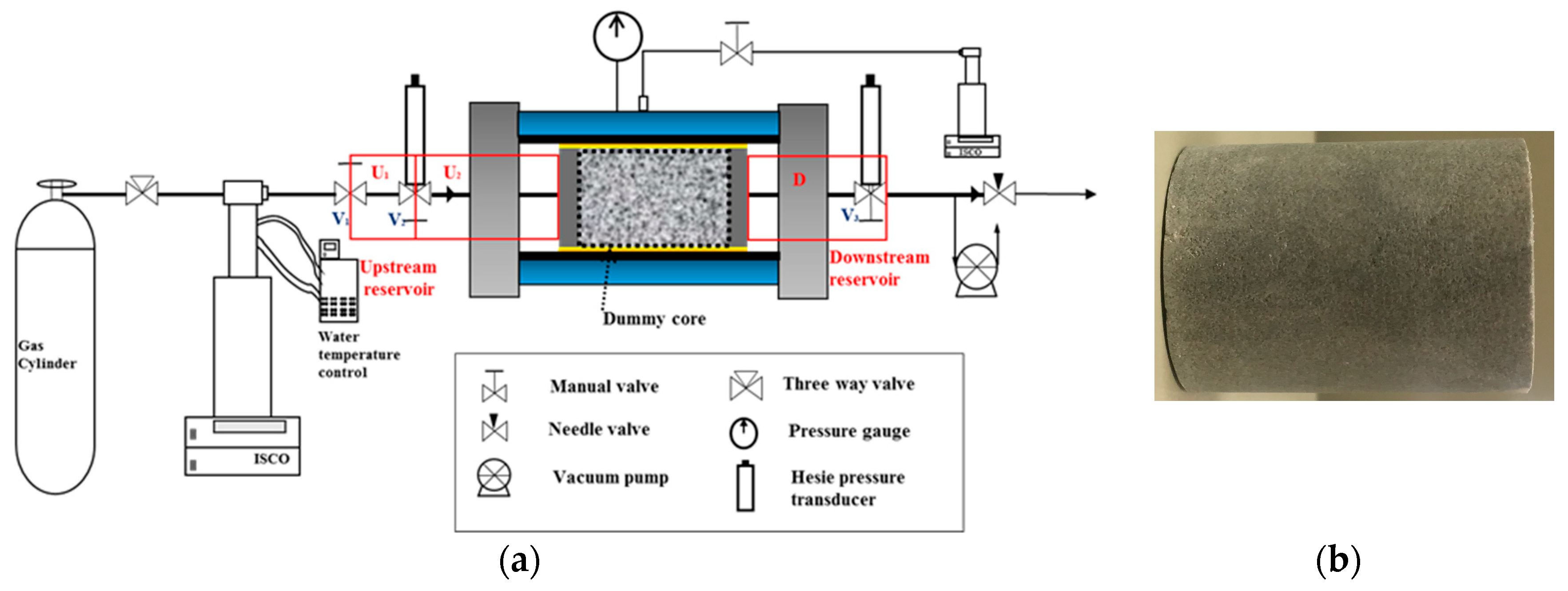
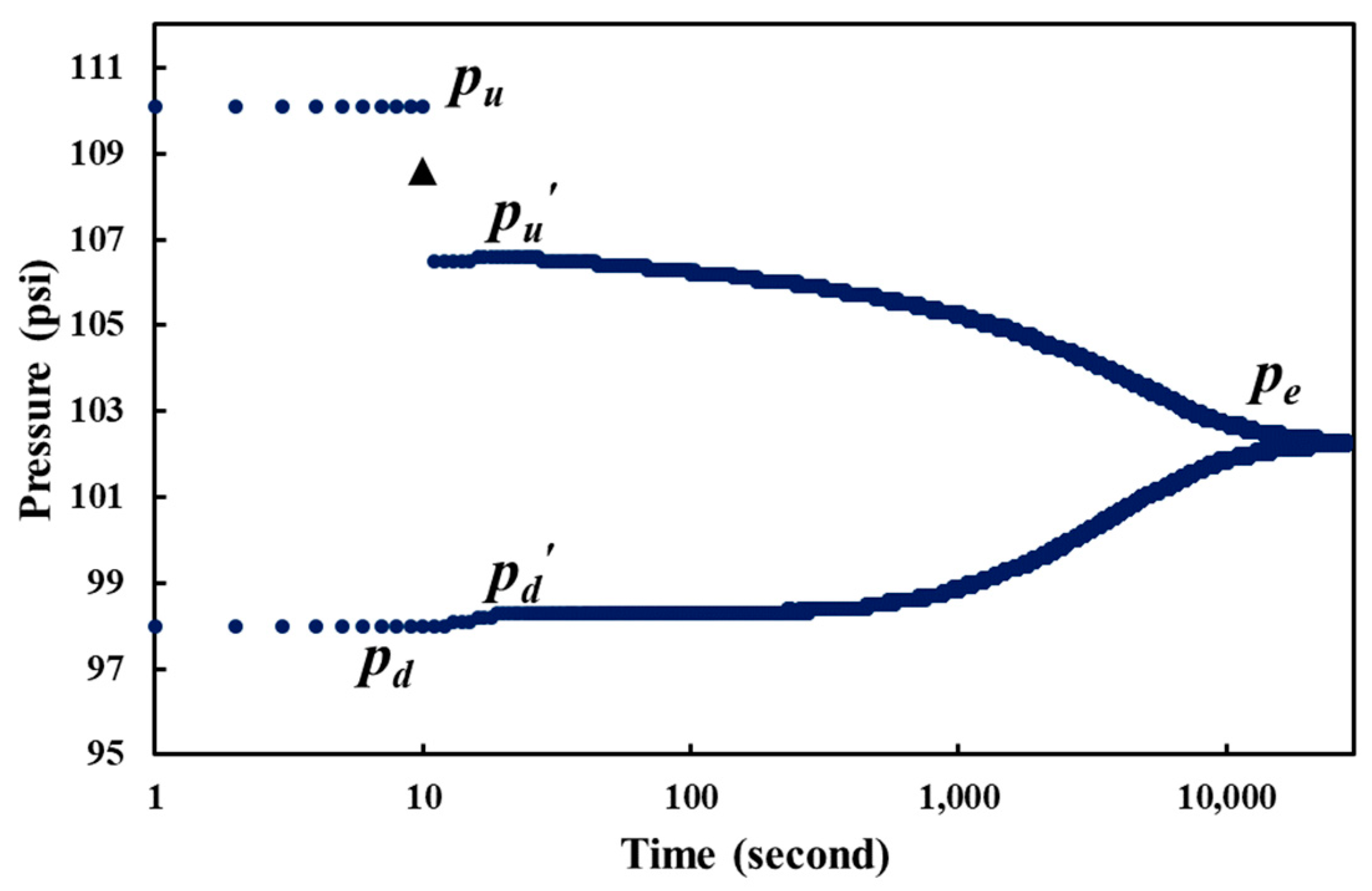
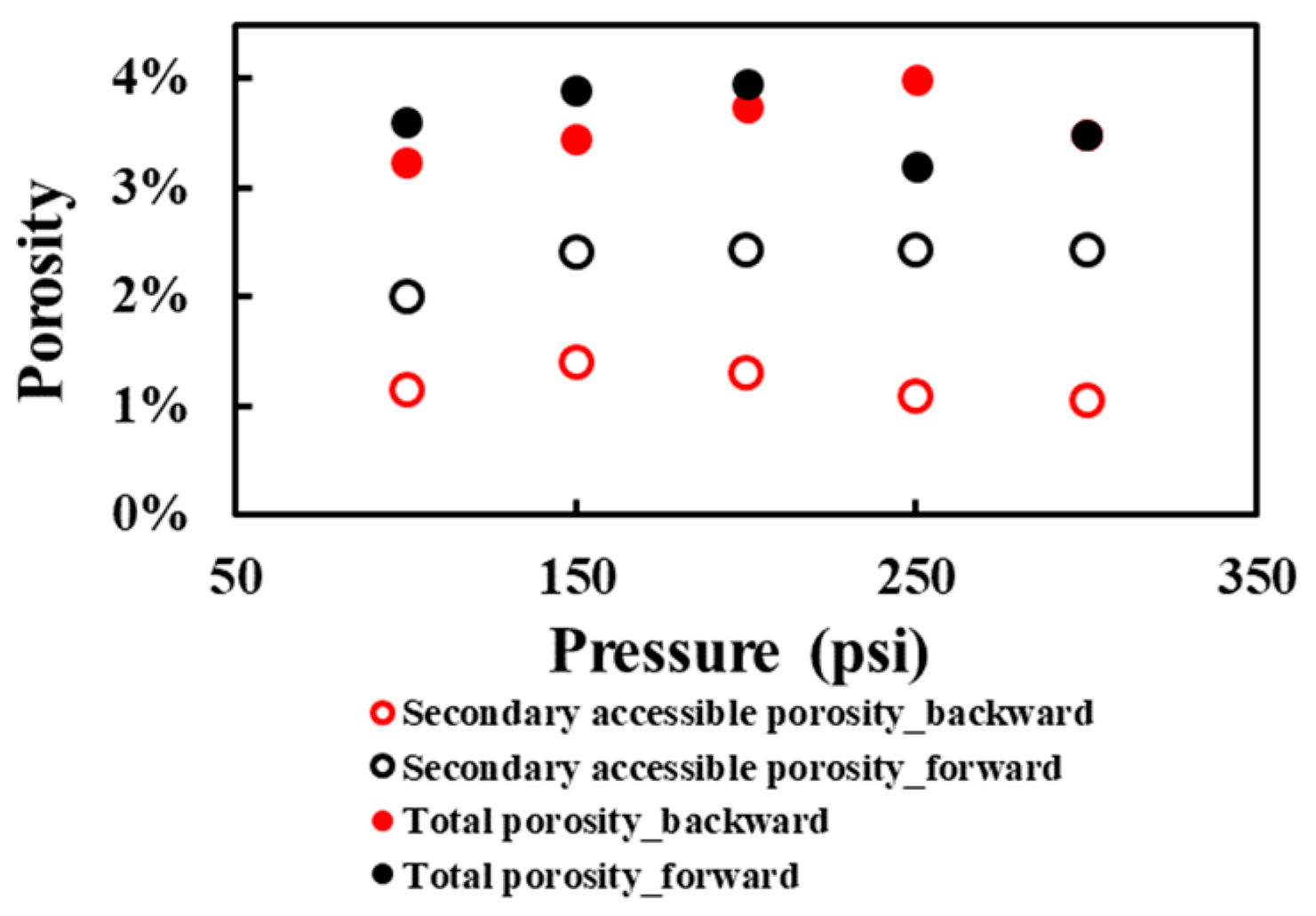
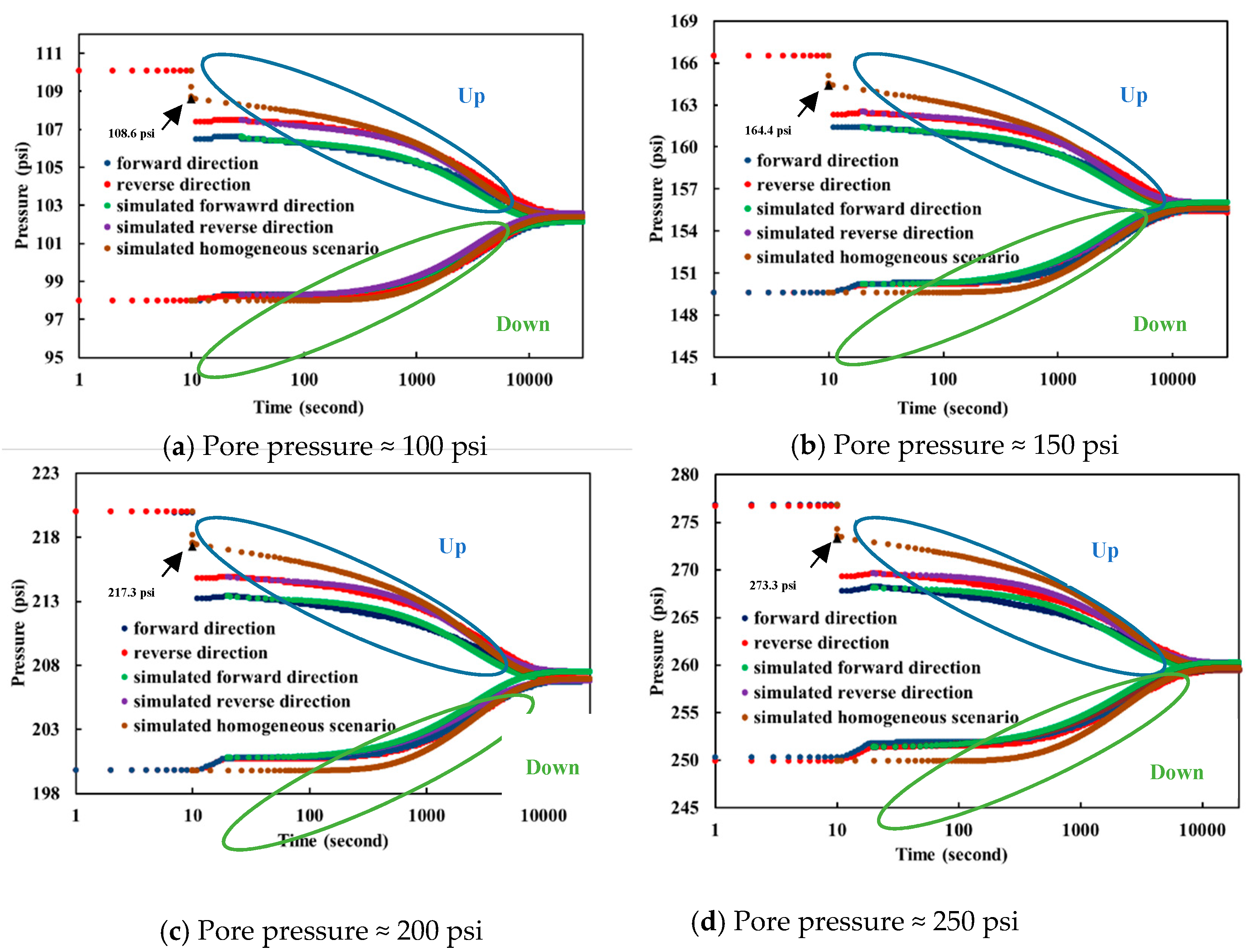
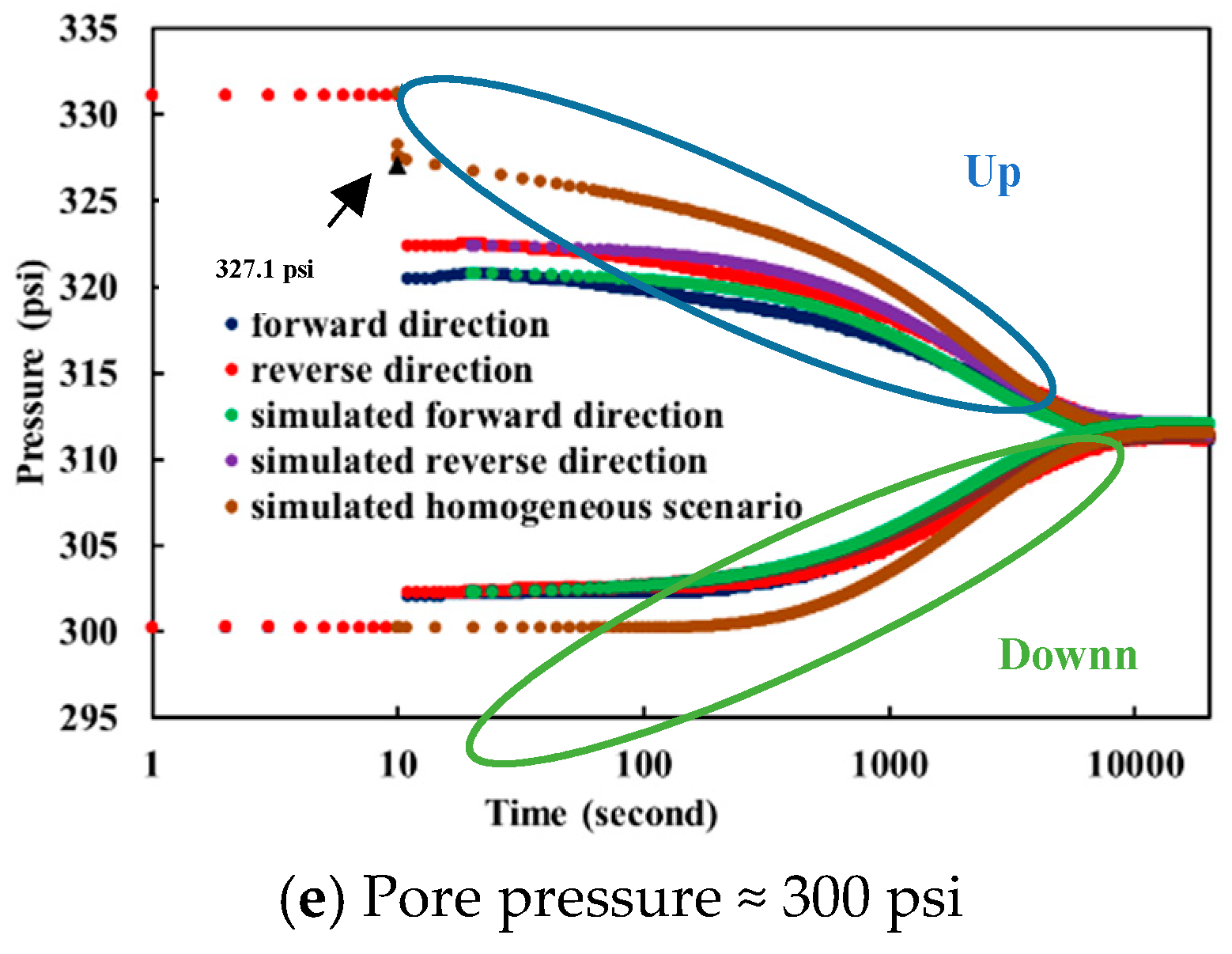
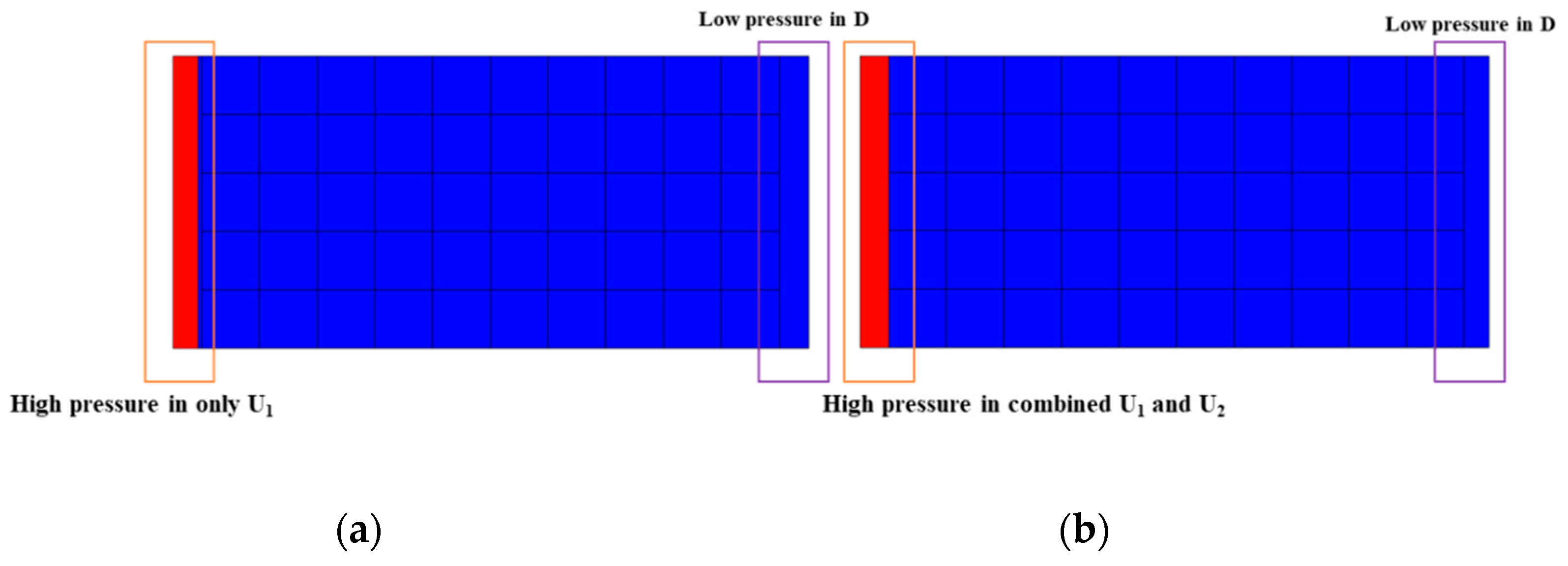
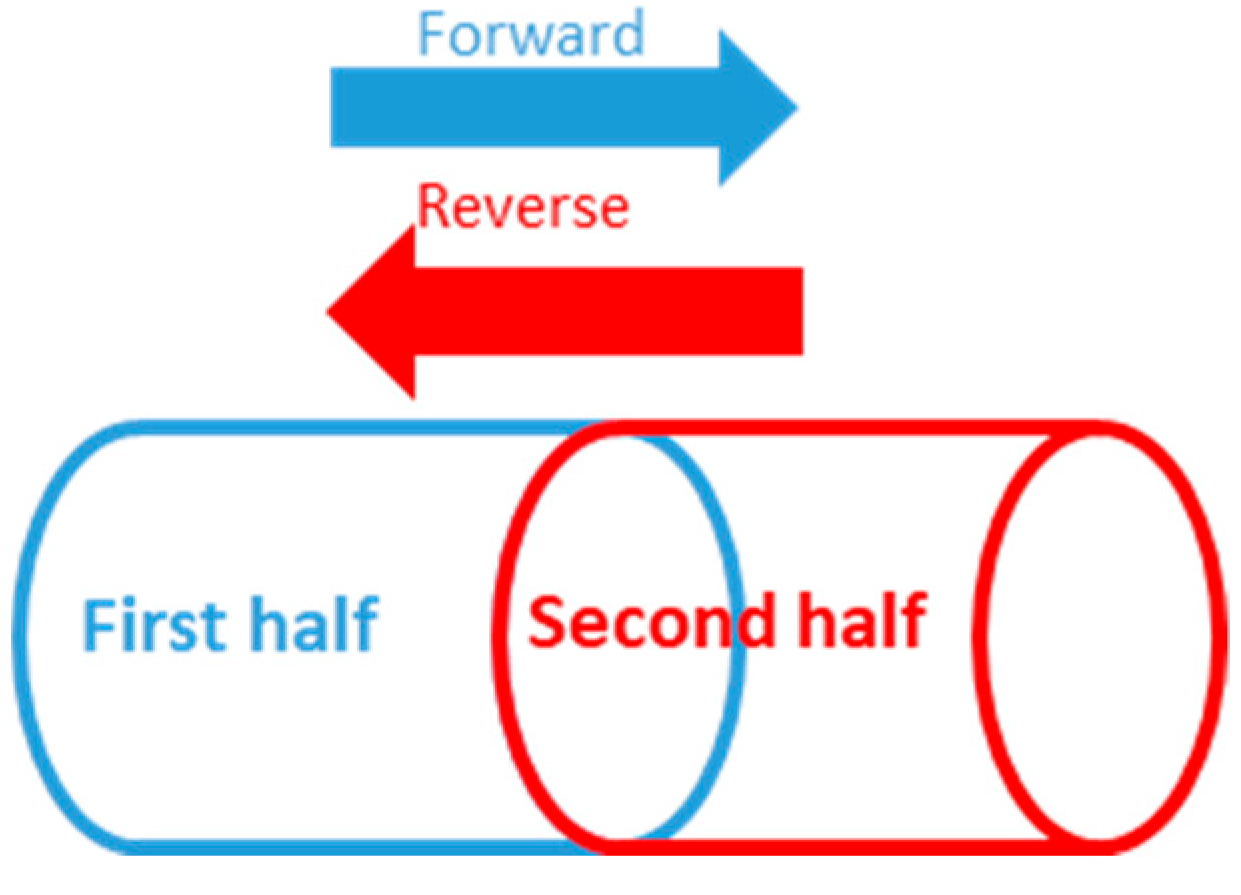
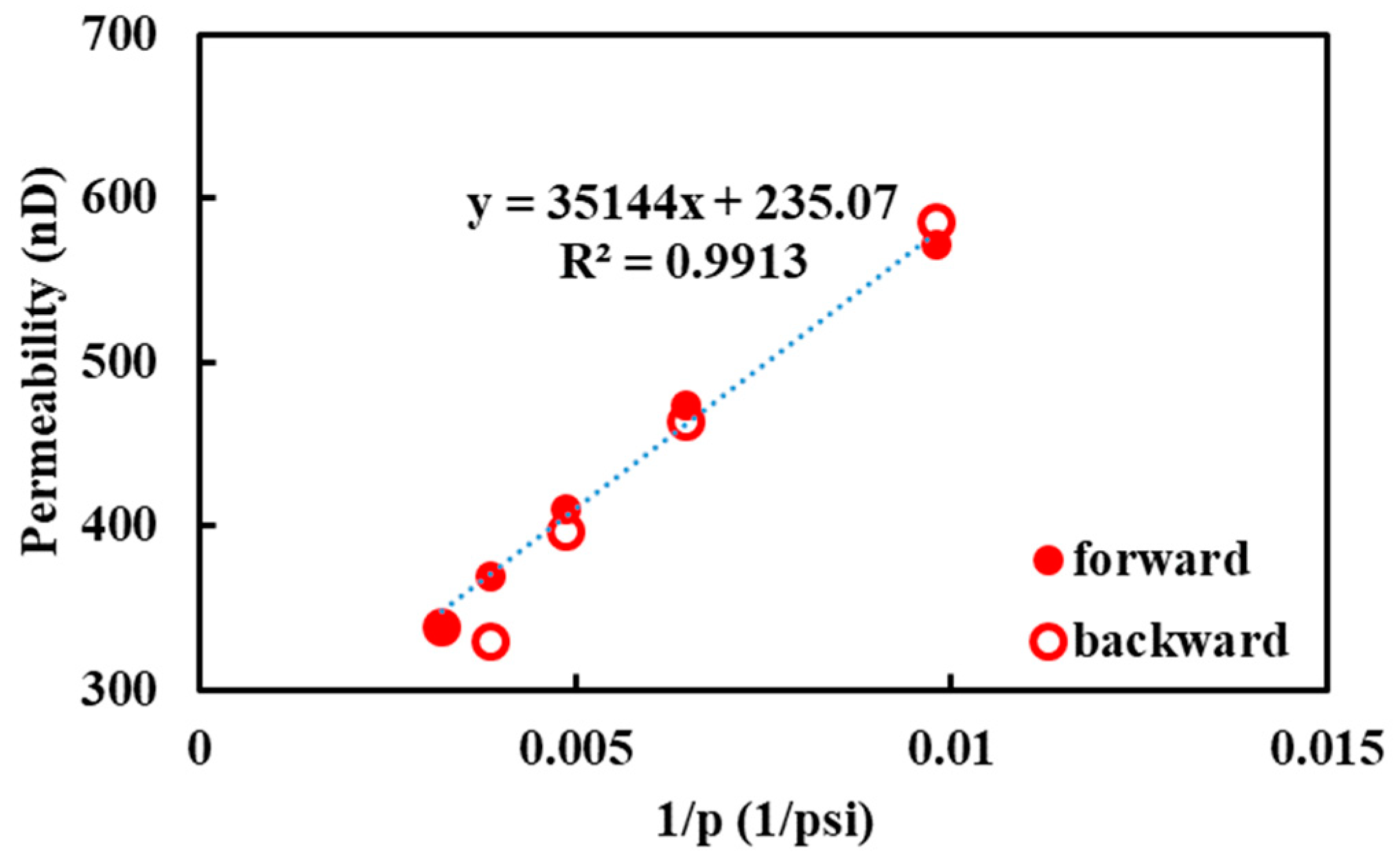
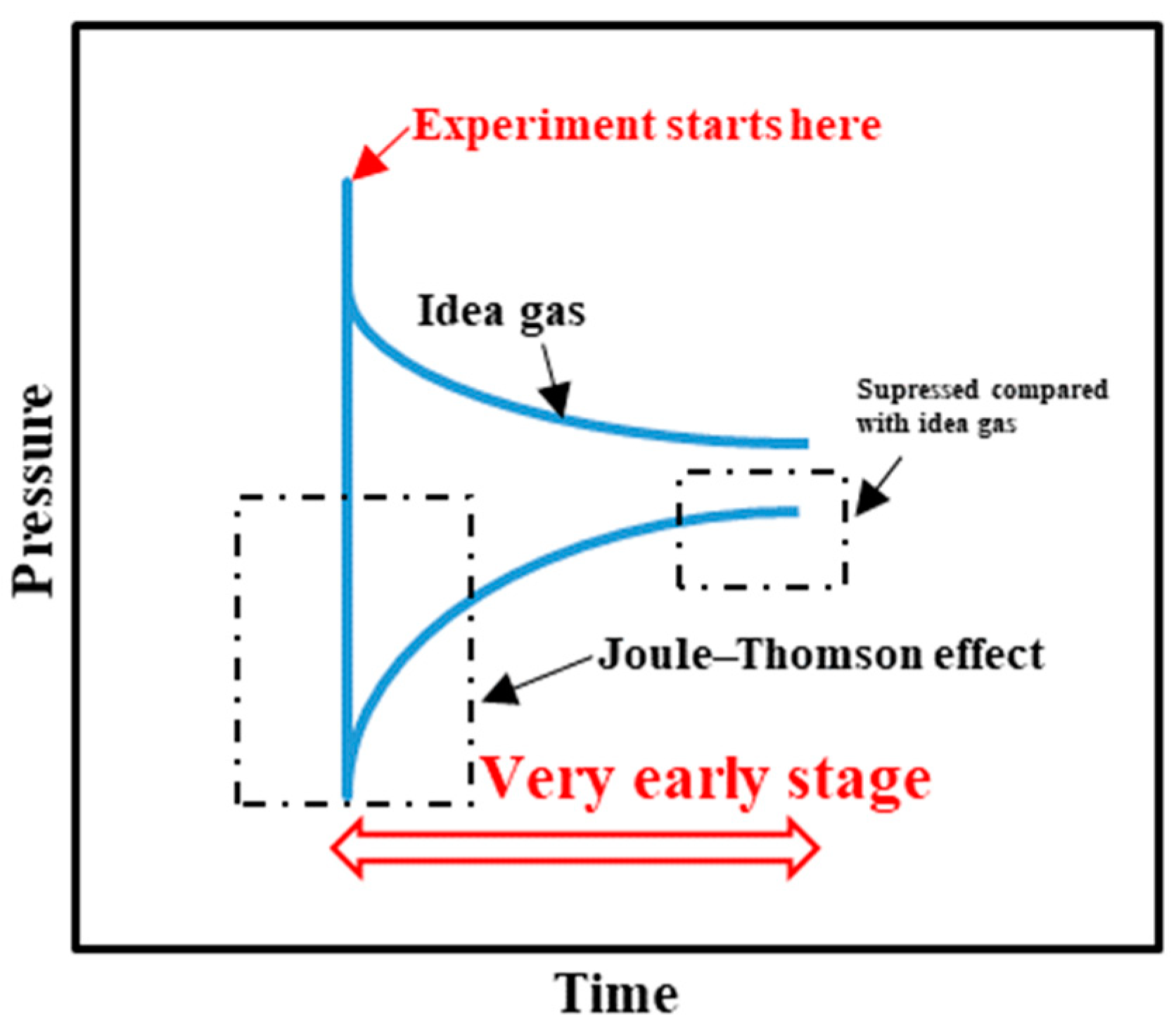

| Author | Contribution |
|---|---|
| Brace et al. [8] | Firstly applied pulse-decay method to measure the permeability of granite |
| Lin [18] | Put forward the basic numerical model for the pulse-decay process |
| Hsieh et al. [9] | Presented complete and restrictive analytical solution for pulse-decay process |
| Dicker and Smits [11] | Simplified the complete analytical solution with acceptable accuracy |
| Kamath et al. [14] | Characterized heterogeneity and microcrack of synthetic cores using the pulse-decay method |
| Ning [10] | Explored dual porosity and dual permeability of fractured cores analytically and numerically |
| Jones [19] | Proposed valuable recommendations for pulse-decay experimental set-up design, for example, using cores with a large diameter and short length |
| Cui et al. [12] | Extended the flowing fluid from non-adsorptive gas to adsorptive gas |
| Civan et al. [20] | Incorporated other important variables in the numerical settings of pulse-decay |
| Cronin [15] | Numerically explained the impacts of anisotropy and microcrack on the pulse-decay pressure response |
| Bhandari et al. [16] | Measured vertical and horizontal permeability of the Barnett shale |
| Alnoaimi [19] | Numerically matched pressure curves of non-adsorptive gas and adsorptive gas during a pulse-decay experiment |
| Jia et al. [13] | Comprehensively investigated flow behaviors of adsorptive and non-adsorptive gas in a wide range of pressure in a tight core using the pulse-decay method |
| Properties | pu | pd | pu′ | pd′ | pe |
|---|---|---|---|---|---|
| Pressure, psig | 110.1 | 98 | 106.6 | 98.3 | 102.3 |
| Compressibility factor, Z | 0.9989 | 0.9990 | 0.9990 | 0.9990 | 0.9990 |
| Properties | 100 | 100 | 150 | 150 | 200 | 200 | 250 | 250 | 300 | 300 |
|---|---|---|---|---|---|---|---|---|---|---|
| Initial upstream pressure pu′ (psi) | 106.5 | 107.5 | 161.4 | 162.5 | 213.4 | 214.9 | 268.2 | 271.3 | 320.8 | 322.5 |
| Initial downstream pressure pd′ (psi) | 98.3 | 98.2 | 150.1 | 150.2 | 200.7 | 200.7 | 251.4 | 251.2 | 302.2 | 302.4 |
| Initial pressure differential (pu′ − pd′) (psi) | 8.2 | 9.3 | 11.3 | 12.3 | 12.7 | 14.2 | 16.8 | 20.1 | 18.6 | 20.1 |
| Initial pressure differential (pu − pd) (psi) | 12.1 | 12.1 | 16.9 | 16.9 | 20.2 | 20.2 | 26.9 | 27.2 | 30.8 | 30.8 |
| Flow direction | Forward | Backward | Forward | Backward | Forward | Backward | Forward | Backward | Forward | Backward |
| Secondarily accessible porosity (%) | 1.2 | 2.0 | 1.4 | 2.4 | 1.3 | 2.4 | 1.1 | 2.4 | 1.1 | 2.4 |
| Permeability (nD) | 572.5 | 586.0 | 473.5 | 464.5 | 410.5 | 397.0 | 370.0 | 329.5 | 338.5 | 338.5 |
© 2019 by the authors. Licensee MDPI, Basel, Switzerland. This article is an open access article distributed under the terms and conditions of the Creative Commons Attribution (CC BY) license (http://creativecommons.org/licenses/by/4.0/).
Share and Cite
Jia, B.; Tsau, J.-S.; Barati, R.; Zhang, F. Impact of Heterogeneity on the Transient Gas Flow Process in Tight Rock. Energies 2019, 12, 3559. https://doi.org/10.3390/en12183559
Jia B, Tsau J-S, Barati R, Zhang F. Impact of Heterogeneity on the Transient Gas Flow Process in Tight Rock. Energies. 2019; 12(18):3559. https://doi.org/10.3390/en12183559
Chicago/Turabian StyleJia, Bao, Jyun-Syung Tsau, Reza Barati, and Fan Zhang. 2019. "Impact of Heterogeneity on the Transient Gas Flow Process in Tight Rock" Energies 12, no. 18: 3559. https://doi.org/10.3390/en12183559
APA StyleJia, B., Tsau, J.-S., Barati, R., & Zhang, F. (2019). Impact of Heterogeneity on the Transient Gas Flow Process in Tight Rock. Energies, 12(18), 3559. https://doi.org/10.3390/en12183559






